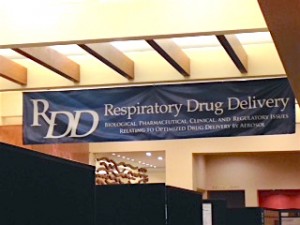 On the first morning of RDD 2016, Peter Byron welcomed over 600 OINDP specialists from approximately 30 different countries to this year’s meeting, which offered an optimistic vision of the future of inhaled and nasal drugs.
On the first morning of RDD 2016, Peter Byron welcomed over 600 OINDP specialists from approximately 30 different countries to this year’s meeting, which offered an optimistic vision of the future of inhaled and nasal drugs.
A number of the presenters described innovative therapies with the potential to cure – not simply to treat the symptoms of – a range of difficult diseases; others spoke about new technologies that may provide a better understanding of the in vivo behavior of inhaled drugs and/or increase how effectively patients use prescribed OINDPs. Some of those technologies were on display for the first time in the technology exhibit, where approximately 80 companies showcased their products and services.
One step on the path toward more realistic in vitro testing of OINDPs took place in 2011 when Copley Scientific launched the Alberta Idealized Throat (AIT) for cascade impactor testing, and this year RDD kicked off the meeting by presenting the he Charles G. Thiel Award for outstanding research and discovery in respiratory drug delivery to the AIT’s inventor, Warren Finlay of the University of Alberta.
Charles Thiel himself presented the award to Prof. Finlay, who founded and directs the Aerosol Research Laboratory of Alberta (ARLA) and has authored numerous articles on aerosols as well as a book titled, “The Mechanics of Inhaled Pharmaceutical Aerosols.”
Following the presentation of the Charles G. Thiel Award, Daniela Riccardi of the University of Cardiff presented the plenary lecture, titled “Inhaled Calcilytics: Effects on Airway Inflammation and Remodeling,” in which she described the role of calcium-sensing receptors (CaSRs) in both airway hyperresponsiveness and inflammation, and the potential for inhaled CaSR antagonists (calcilytics) to interrupt both processes.


